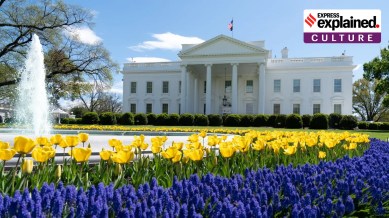As Trump moves to make ‘govt buildings beautiful again’, a look at three values classical architecture gave to modernism
Trump wants to do away with modernist and brutalist buildings to go back to classical forms. Modernism, however, is not entirely de-linked from classical architecture. Here's how

US President Donald Trump wants to make federal buildings great again. A White House Executive Order (EO) issued on August 28, titled Making Federal Architecture Beautiful Again, has held that new federal buildings would be designed in classical and traditional styles.
This is the third EO on the subject, with the first issued during Trump’s first presidency in 2020, though not much has changed on the ground yet.
The EO terms ‘classical architecture’ as derived from the forms, principles and vocabulary of the architecture of Greek and Roman antiquity, which has been refined by Renaissance architects and 20th-century practitioners.
In the EO, Trump states: “The Founders…consciously modeled the most important buildings in Washington, D.C., on the classical architecture of ancient Athens and Rome. They sought to use classical architecture to visually connect our contemporary Republic with the antecedents of democracy in classical antiquity, reminding citizens not only of their rights but also their responsibilities…”
It adds that in the 1960s, “the Federal Government largely replaced traditional designs for new construction with modernist and brutalist ones”, which was “often unpopular…many in the public found unappealing.”
Modernism, however, is not entirely de-linked from classical architecture.
Some of the well-known architects of modernism, like Le Corbusier, Alvar Aalto and Mies van der Rohe, drew inspirations from classical tools of design. If in Mies’s Barcelona Pavilion (1929), the architectural plans present balanced and classical proportions, Corbusier’s Villa Savoye — built around the same time, and which hugely influenced modernism — also carried grains of classical architecture. Likewise, Aalto’s early Finnish work, too, was a salute to what neo classical forms had taught him.
What is classical architecture?
Classical architecture was born out of the Athenian idea of democracy. The Greeks and Romans wanted buildings to represent the values and social and cultural aesthetic of its people. Its fundamental principles included balance, proportion and beauty. With its columns, domes, arches, dressed stone and “society of rooms”, where each room had a place and purpose, this tradition placed a premium on monumentality and mass.
Classical architecture in America: Then and now
It’s a style that former US presidents embedded into the landscape. George Washington (Mount Vernon) and Thomas Jefferson (Monticello, also a UNESCO Heritage Site) designed their own homes in the neoclassical style.
The first important government buildings, the White House and the Capitol, are also designed in a similar fashion, keeping columns and symmetry at the forefront.
The Federal Triangle, the area in Washington DC developed between 1928 and 1938, has now become emblematic of a grand capital city, which houses important offices, including the Internal Revenue building and the US Customs and Border Protection headquarters.
A National Civic Art Society Survey conducted in 2020 showed “that Americans strongly prefer a more traditional look when it comes to the architecture of US courthouses and federal office buildings”.
However, not everyone has welcomed the latest EO by Trump.
The March 2025 issue of The Nation magazine states that these directives could “effectively divert our attention away from the policies that Trump is fomenting… His tariffs will have a devastating impact on the construction industry, as will his draconian immigration policies, which will target both white-collar workers within architecture and the primary labor force that builds the country’s architecture…These outcomes will be worse for architecture than the mandate of a few cheesy columns that may or may not ever get built. It’s not just aesthetics that Trump is turning back the clock on — it’s any and all progress.”
Continuing relevance, beyond Trump
One of America’s most vocal architects about Classical Architecture, Allan Greenberg has been talking about why this style matters – not only does it honour site and context but it also becomes a yardstick to measure the timeless nature of a building. That is, perhaps, why many modern-day architects continue to hold these concepts as integral to their projects.
Here are three primary values of classical architecture that we continue to see in today’s buildings:
The person at the centre
Classical architecture was anthropomorphic in its design, in that it used the human body as a model for buildings. Greenberg says, “The ancient Greeks used columns and statues of people interchangeably. Columns typically have capitals, like human heads, formed their tops and the base corresponded to feet”.
In BV Doshi’s autobiography, Paths Uncharted (2011), he recalls taking Corbusier to a jeweller’s shop in Manek Chowk. “He lay down on the floor, measured it and found that it was no more than the length of his body,” Doshi writes, “…He tried to give man dignity through his dwelling. He would scale the building in such a way that no man felt less than a king in his house.”
Monumentality
With its repetitive columns, arches and domes, classical architecture gave an aspiration quality to spaces. Architects of the 21st century have also used repetitive conventions in their projects, be it the imposing skyscrapers or the dizzying towers that mark global landscapes today. The White House itself has planned a 90,000 sq ft State Ballroom which promises to be an ornately designed and carefully crafted space.
Innovation in material
The Ancient Greeks did away with wood and brought in stone into their buildings to give a sense of permanence. Modern architects, too, have been experimenting with materials.
Taking forward the use of steel in bridges and lampposts, today we barely give a thought when steel frames are adapted into building structures. Mechanical ventilation made room for air conditioning, and hospital architecture of the 19th century, with its emphasis on hygiene and natural light, made way for large windows and cross-ventilation, allowing for ample light and fresh air into homes today.